Those who live in places where it’s snowing in winter know the excitement of seeing the first snowflakes.
As everything turns white, our enthusiasm for photography grows. We see the world in a completely new way.
But snow photography is not the easiest thing, you have to prepare for it. We collected some ideas and tips for you to start shooting photos in the snow.

1. Snow Photography: Using Manual or Aperture Priority Mode
Manual mode gives full control over your settings, which can be useful regarding that shooting snow is not too easy. You can bring the most out of your shots by setting everything as you wish.
But if you are cold, you might want to operate with as few camera adjustments as possible. You might choose aperture priority mode instead.
It still gives you great freedom, but you can concentrate more on what depth of field you want to reach. You set the aperture value, and then the camera adjusts the shutter speed and the ISO for you.

2. Shoot Snow Photos in RAW
You should shoot in RAW for most kinds of photography. But it can be crucial when it comes to photographing snow.
The white snow is going to be the brightest and most highlighted part of your images. And it can fill almost the whole frame.
RAW is a lossless, uncompressed format which means that it contains the most detail. It makes post-processing easier and more effective. You’ll be able to pull out details from the bright areas.
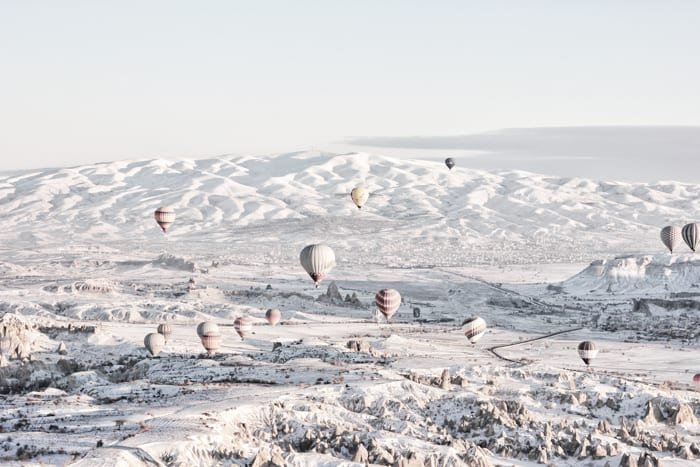
3. Rely on Your Histogram
Your LCD screen is not going to show you the colors and the details of your images accurately. It’s also a tiny screen which limits how well you see your photos on it.
This is why you should learn how to read your histograms. They show you scientifically how well exposed your images are which is necessary for a correct exposure.
It can be especially important in snow photography because your screen’s brightness problems might result in completely useless images.
By relying on the histogram, you can see the dynamic range of tones. This helps to avoid overexposing or underexposing your images.

4. Make Sure to Set Up the Right White Balance
Finding the correct white balance can be tricky. Snow has a blueish tone when it’s not directly lit by sunlight, because these times it reflects the blue sky.
You might want to compensate it, so set your white balance manually.
You can set it to shade mode or take a white balance preset from the snow. These two techniques are going to give a warmer and more realistic tone.
You can also try exposure compensation to balance the blue or grey of the snow. This is going to need +1 or +2 stops compensation. It helps the snow to stay white.
This may result in overexposed images, but your images are going to be softer. And you can take back from it during post-processing.
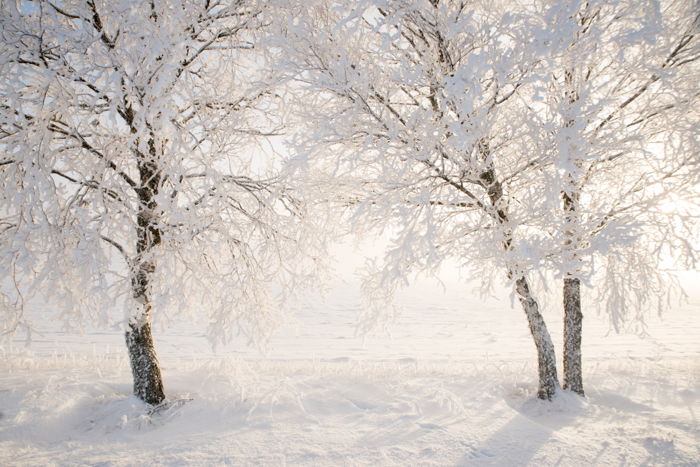
5. Use a Lens Hood and a Polarising Filter to Limit Reflections
Snow reflects a lot of light, especially in sunny weather. This can result in light leaks and unwanted blurs or reflections in your images.
Your lenses come with a lens hood. This is a basic part of your gear, but you might not use it. Well, for snow photography, you should.
It stops lens flares from getting into your camera and reaching the sensor. Besides this, it protects your lens from the falling snow and other physical impacts.
Another solution against lens flares is using a polarising filter. It sits on the front element of your lens, and just like the lens hood, it can protect it. But this is not the best of its functions.
It eliminates unwanted reflections and it helps to darken bright surfaces.
With a circular polarising filter you can control the strength of the polarizing effect. It helps to keep details in the bright areas.

6. Wake Up Early to Catch Magical Sunrises
Winter is not the shiniest time of the year. But we can be lucky enough to have a few sunny days with snow, and these times are magical!
Snow reflects light and it’s sparkling. It’s beautiful during the whole day, but in the mornings you can catch surreal lights.
The golden hour won’t last too long, so you’ll have to wake up before sunrise.
Be ready on the spot where you want to shoot, and wait for the first rays to come!
For this, you should follow the . You’ll save yourself from a few unnecessary rounds in cloudy winter mornings.
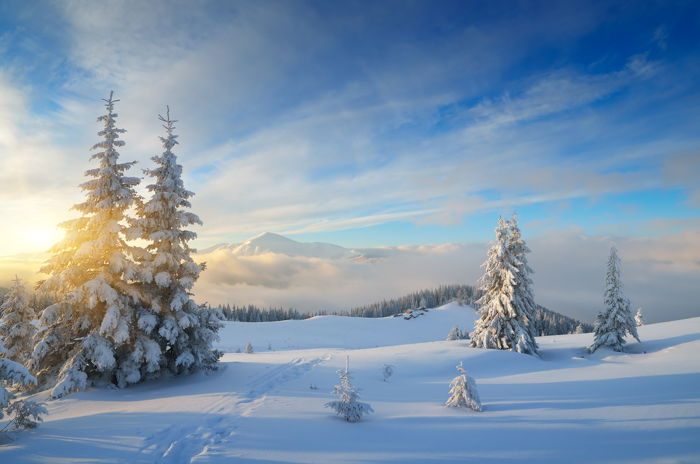
7. Capture Sunsets and Blue Hours to Create Contrast
Just as sunrises, sunsets are a bit different in snowy times.
Red skies and then the blue hour is going to make an interesting contrast with the white of snow.
Usually, the ground gets dark first and the sky stays bright for a little longer. This changes in snow as it reflects the last rays of the sun too and then the moonlight.
Of course, the landscape is not going to be as bright white as it is during the day. But can enhance this phenomenon during post-processing.

8. Emphasise Winter Tones to Get Drawing-Like Images
Snow changes the tones of everything. White surfaces become more dominant than others. This gives a surreal change of colors.
If the sun is not shining and clouds filter the light, the whole snowy scene can appear in different tones of grey.
Your images will almost look like you were shooting in black and white.
Use this to make minimalist sketch-like snow photography images.
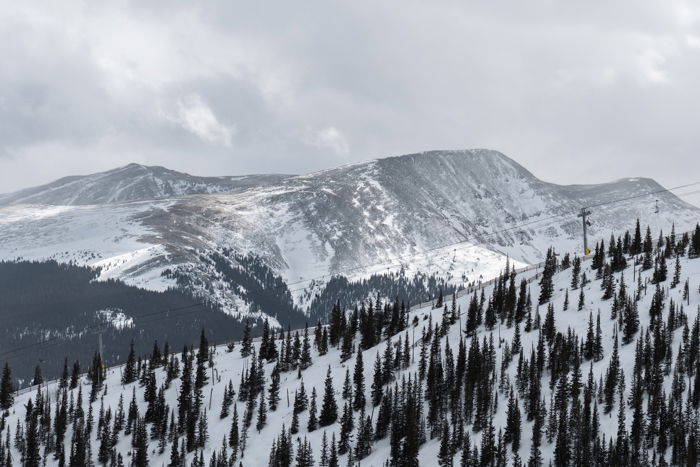
9. Capture Snow Photography Bokeh
Bokeh is a popular addition to every kind of photography. Photographing snow is not an exception either.
To create bokeh, you’ll need a fast lens. A wide aperture is needed for creating bokeh. Set it anywhere from f/1.2 to f/1.8. You can try with a bit higher f-number, but this interval is the best.
A telephoto lens might be able to create bokeh with a little smaller f-number too.
When the snow is falling, focus your camera on your subject. If it’s far from you, the bokeh created by the snowflakes will appear in the foreground. If the subject is closer, it’s going to be in the background.
If you use a flash, the snowflakes might be more visible in the foreground.
Otherwise, you’ll need a fast shutter speed to freeze the snowflakes in the air.

10. Try Snowflake Photography to Show the Beauty In the Details
Try winter macro photography!
When we talk about snow photography, we usually imagine snow-covered landscapes. But it takes uncountable snowflakes to build up these scenes.
Use your camera to show the beauty in the details and try snowflake photography. It’s a great way of guiding your viewers to a wonderworld that is not even visible to the naked eye.
Someone’s coat, gloves or hats can give a nice background to the fallen snowflakes. A darker surface can enhance the shapes beautifully.

11. Keep the Camera Acclimatised to Avoid Damaging It
Going from a warm place to a cold one is going to affect your camera equipment.
And going back from outside is also risky. It’s like when you wear glasses and they steam up immediately as you step in. The same thing happens with your camera lens.
Then the moist getting inside your lens can cause lens fungus which is much harder to deal with than acclimatisation.
To avoid this, you need to slowly acclimatise your gear.
Use a zip-lock bag or any other waterproof one. Before you go back to room temperature, place the camera in it and take it inside like this.
Leave the whole package for a while to keep the condensation on the outside of the bag.

12. Buy a Rain Cover to Protect Your Camera
Snow is not so different from rain. It is water too, just in a different form. But when it gets to your camera, it can soak it just as rain would.
If you are shooting during snowfall, we recommend using a rain cover.
We advise you to opt for the Powerextra Professional Waterproof Camera Rain Cover.
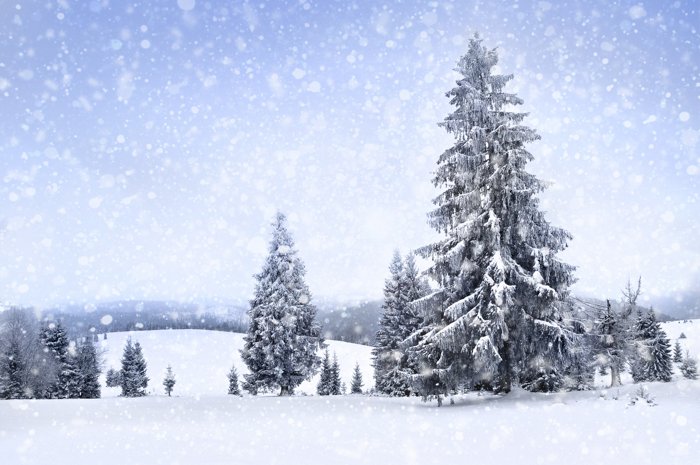
13. Stock Up on Microfiber Cloths and Extra Batteries
Cold winter weather can result in a lot of moist getting on and into your camera. It’s a necessity to have microfiber cloths with you when shooting snow photos.
Use these to clean your lens and camera body regularly. They won’t scratch your gear, so you can clean it gently.
If moist sits on your camera, it can freeze to a thin layer of ice and you definitely don’t want that.
Not to mention the lens fungus it can cause if it gets inside.
Also, cold weather makes your batteries run out quickly. Always keep at least one extra in your pocket. If possible, place it close to your body to keep it warm.

14. Don’t Let the Weather Stop You
One of the most basic snow photography tips we can give you is to prepare for the weather.
It might sound silly at first, but once you are outside, you’ll see it’s good to have a reminder.
When cold weather hits, we like to stay inside and enjoy room temperature. But don’t let the weather stop you!
In most regions, snow is rare, and it gives a unique sight of the world. Snowy landscape images are rarer than other kinds. Use these periods to shoot outstanding images.
It’s a perfect time for street photography as well. People behave a little differently in the changing environment.
They can struggle with walking in the snow. Or enjoy themselves and build snowmen with children at the most unexpected places. Focus on these out-of-the-common moments and use them to tell stories.
For this, you’ll have to dress in layers to stay warm. Wear a warm coat, a scarf and a hat. Wear gloves that allow you to press the buttons on your camera and use the touchscreen of your phone.
Snow can be really shiny, so in sunny weather, it’s advised to wear sunglasses to prevent snow blindness.
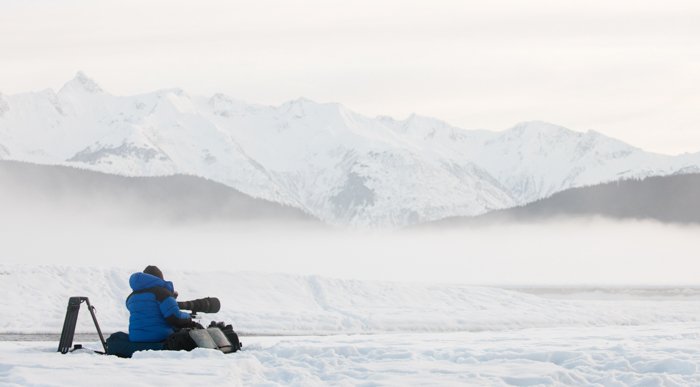
Conclusion
Snow is not an easy-to-capture subject.
It requires some technical preparations, but hopefully, our snow photography tips will help you to master it.
Make sure to prepare yourself and your camera to the weather.
And don’t forget to take your camera bag even for small walks as you might find beauty on every corner!


